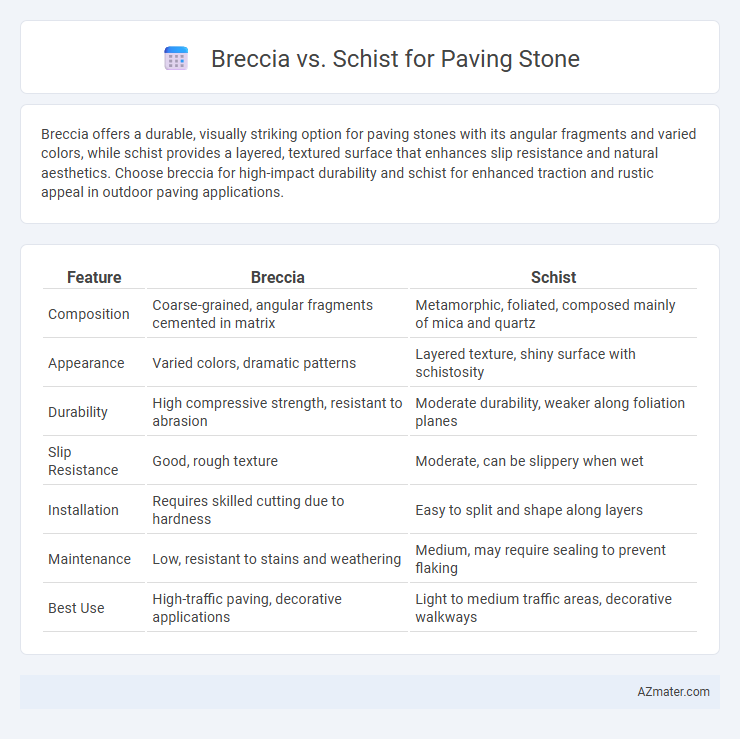Breccia offers a durable, visually striking option for paving stones with its angular fragments and varied colors, while schist provides a layered, textured surface that enhances slip resistance and natural aesthetics. Choose breccia for high-impact durability and schist for enhanced traction and rustic appeal in outdoor paving applications.
Table of Comparison
| Feature | Breccia | Schist |
|---|---|---|
| Composition | Coarse-grained, angular fragments cemented in matrix | Metamorphic, foliated, composed mainly of mica and quartz |
| Appearance | Varied colors, dramatic patterns | Layered texture, shiny surface with schistosity |
| Durability | High compressive strength, resistant to abrasion | Moderate durability, weaker along foliation planes |
| Slip Resistance | Good, rough texture | Moderate, can be slippery when wet |
| Installation | Requires skilled cutting due to hardness | Easy to split and shape along layers |
| Maintenance | Low, resistant to stains and weathering | Medium, may require sealing to prevent flaking |
| Best Use | High-traffic paving, decorative applications | Light to medium traffic areas, decorative walkways |
Introduction to Breccia and Schist Paving Stones
Breccia and Schist are popular natural stones used for paving due to their unique textures and durability. Breccia features angular fragments cemented together, offering a rugged and visually striking surface ideal for rustic and modern outdoor spaces. Schist, characterized by its foliated, layered structure, provides a smooth yet textured finish, making it suitable for elegant and versatile paving applications.
Geological Formation and Characteristics
Breccia is a clastic sedimentary rock composed of angular fragments cemented together, indicating a high-energy environment such as landslides or fault zones, which results in its coarse texture and rugged appearance ideal for rustic paving stones. Schist is a metamorphic rock formed under moderate to high temperature and pressure, characterized by its foliated structure and visible mineral grains, providing a durable yet aesthetically appealing surface with natural sheen for paving applications. The distinct geological formation processes of breccia and schist influence their durability, texture, and visual appeal, making breccia tougher for heavy use and schist preferred for decorative paving.
Visual Appearance and Color Variations
Breccia paving stones showcase a dynamic visual appearance characterized by angular fragments cemented within a contrasting matrix, offering bold patterns and rich, varied color tones ranging from deep reds and browns to greys and whites. Schist, with its foliated texture and shimmering mica content, presents a more uniform yet naturally textured look, often seen in earthy hues like slate gray, green, and bronze, enhancing subtle depth and elegance. Color variations in Breccia tend toward dramatic contrasts and striking patterns, while Schist provides consistent, muted shades with a layered visual complexity ideal for sophisticated paving designs.
Strength and Durability Comparison
Breccia offers moderate strength and durability, making it suitable for light to medium traffic paving applications, though it may wear faster under heavy loads due to its fragmented composition. Schist, characterized by its foliated texture and layered mineral grains, provides higher durability and resistance to weathering, making it ideal for heavy traffic areas and outdoor paving exposed to harsh conditions. The interlocking mineral structure of schist enhances its mechanical strength, resulting in longer-lasting paving stones compared to breccia.
Slip Resistance and Surface Texture
Breccia offers a coarse, angular surface texture that enhances slip resistance, making it a reliable choice for paving stone in outdoor environments prone to moisture. Schist features a foliated, layered texture with natural clefts that provide moderate slip resistance but may become slippery when wet due to its smoother mineral surfaces. Selecting breccia benefits areas requiring higher traction, while schist is preferred for aesthetic appeal with moderate safety considerations.
Weathering and Maintenance Requirements
Breccia demonstrates superior weather resistance compared to schist, making it more suitable for outdoor paving stones subject to harsh environmental conditions. Schist's foliated structure can lead to higher susceptibility to flaking and erosion, increasing maintenance demands such as sealing and repointing. Breccia requires less frequent upkeep due to its compact matrix, ensuring greater durability and lower long-term maintenance costs in paving applications.
Installation Process and Workability
Breccia offers easier workability for paving stone installation due to its coarse, angular fragments that provide good interlocking and stability, reducing the need for extensive cutting or shaping. Schist's foliated structure demands more precise cutting and handling during installation, increasing labor time and complexity. Breccia's durability and natural texture enhance grip, making it more suitable for efficient paving projects with lower installation costs.
Cost Analysis: Breccia vs Schist
Breccia paving stones typically have a moderate cost due to their unique angular fragment textures and diverse mineral composition, making them visually striking yet reasonably priced. Schist, characterized by its foliated, layered structure and rich mineral content, often commands a higher price because of its durability and polished finish suitable for upscale applications. Cost analysis reveals breccia as a budget-friendly option for decorative paving, while schist is preferred for long-lasting, elegant surfaces despite the higher initial investment.
Sustainability and Environmental Impact
Breccia and schist differ significantly in sustainability and environmental impact when used as paving stones, with breccia often sourced from quarries that promote eco-friendly extraction methods reducing habitat disruption. Schist, characterized by its foliated texture, typically requires less processing due to its natural cleavage, lowering energy consumption and carbon emissions during production. Both stones offer durable, long-lasting solutions that minimize the need for frequent replacement, contributing to sustainable landscaping practices.
Best Applications: Choosing the Right Stone for Your Project
Breccia's angular fragments and varied colors make it ideal for decorative paving where visual interest and texture are priorities, especially in garden paths and patios. Schist's foliated structure and natural cleavage offer excellent slip resistance and durability, making it a superior choice for high-traffic areas and outdoor steps with a rustic aesthetic. Selecting the right stone depends on project requirements for durability, maintenance, and design, with breccia preferred for aesthetic appeal and schist for functional resilience.

Infographic: Breccia vs Schist for Paving Stone
 azmater.com
azmater.com